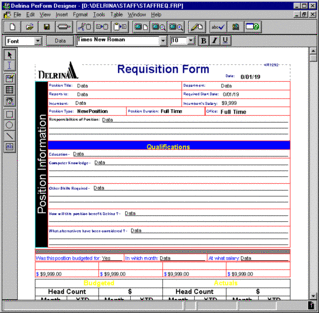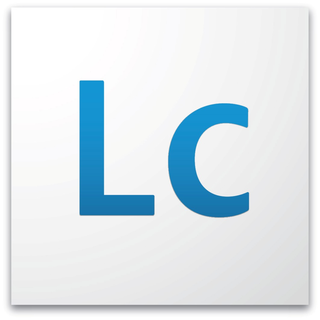
PostScript is a page description language and dynamically typed, stack-based programming language. It is most commonly used in the electronic publishing and desktop publishing realm, but as a Turing complete programming language, it can be used for many other purposes as well. PostScript was created at Adobe Systems by John Warnock, Charles Geschke, Doug Brotz, Ed Taft and Bill Paxton from 1982 to 1984. The most recent version, PostScript 3, was released in 1997.

Laser printing is an electrostatic digital printing process. It produces high-quality text and graphics by repeatedly passing a laser beam back and forth over a negatively charged cylinder called a "drum" to define a differentially charged image. The drum then selectively collects electrically charged powdered ink (toner), and transfers the image to paper, which is then heated to permanently fuse the text, imagery, or both, to the paper. As with digital photocopiers, laser printers employ a xerographic printing process. Laser printing differs from traditional xerography as implemented in analog photocopiers in that in the latter, the image is formed by reflecting light off an existing document onto the exposed drum.

The LaserWriter is a laser printer with built-in PostScript interpreter sold by Apple, Inc. from 1985 to 1988. It was one of the first laser printers available to the mass market. In combination with WYSIWYG publishing software like PageMaker that operated on top of the graphical user interface of Macintosh computers, the LaserWriter was a key component at the beginning of the desktop publishing revolution.

Daisy wheel printing is an impact printing technology invented in 1970 by Andrew Gabor at Diablo Data Systems. It uses interchangeable pre-formed type elements, each with typically 96 glyphs, to generate high-quality output comparable to premium typewriters such as the IBM Selectric, but two to three times faster. Daisy wheel printing was used in electronic typewriters, word processors and computers from 1972. The daisy wheel is so named because of its resemblance to the daisy flower.

LaserJet as a brand name identifies the line of laser printers marketed by the American computer company Hewlett-Packard (HP). The HP LaserJet was the world's first commercially successful laser printer. Canon supplies both mechanisms and cartridges for most HP laser printers; some larger A3 models use Samsung print engines.
Lexmark International, Inc. is a privately held American company that manufactures laser printers and imaging products. The company is headquartered in Lexington, Kentucky. Since 2016 it has been jointly owned by a consortium of three multinational companies: Apex Technology, PAG Asia Capital, and Legend Capital.
Variable Data Intelligent Postscript Printware is an open language from Xerox that enables highest-performance output of variable-data PostScript documents. It is used by the FreeFlow VI Suite (VIPP) front end.
Timeworks Publisher was a desktop publishing (DTP) program produced by GST Software in the United Kingdom and published by Timeworks, Inc., in the United States.
Advanced Function Presentation (AFP) is a presentation architecture and family of associated printer software and hardware that provides for document and information presentation independent of specific applications and devices.

Delrina Corporation was a Canadian software company active from 1988 to 1995. The company was best known for WinFax, a software package which enabled computers equipped with fax modems to transmit copies of documents to standalone fax machines or other similarly equipped computers. It also sold PerForm and FormFlow, electronic form software. Delrina was acquired by the American software firm Symantec in 1995.
WinFax is a discontinued Microsoft Windows-based software product developed and published by Delrina designed to let computers equipped with fax-modems communicate directly to stand-alone fax machines, or other similarly equipped computers.

PerForm and PerForm PRO were electronic form programs, initially designed to work under GEM in DOS. Later versions were designed to work in Windows 3.1, at which point it was succeeded by FormFlow.
FormFlow was the name of a line of electronic forms products initially created and sold by Delrina in the early- to mid-1990s.
Mark Skapinker is a Managing Partner at Brightspark, a software, Internet and Mobile venture capital firm with offices in Montreal, Quebec, Canada and Toronto, Ontario, Canada. Brightspark has twice won the Canadian Venture Capital Association "Deal of the Year Award" for its successful investments in ThinkDynamics and Radian6.
Adobe LiveCycle Designer was a forms authoring tool published by Adobe Systems, intended as a one-stop design tool to render XML forms as PDF or HTML files.

Adobe LiveCycle Enterprise Suite (ES4) is a service-oriented architecture Java EE server software product from Adobe Systems used to build applications that automate a broad range of business processes for enterprises and government agencies. LiveCycle ES4 is an enterprise document and form platform that helps you capture and process information, deliver personalized communications, and protect and track sensitive information. It is utilized for purposes such as account opening, services, and benefits enrollment, correspondence management, requests for proposal processes, and other manual-based workflows. LiveCycle ES4 incorporates new features with a particular focus on mobile devices. LiveCycle applications function in both online and offline environments. These capabilities are enabled through the use of Adobe Reader, HTML/PhoneGap, and Flash Player clients to reach desktop computers and mobile devices.

CPT Corporation was founded in 1971 by Dean Scheff in Minneapolis, Minnesota, with co-founders James Wienhold and Richard Eichhorn. CPT first designed, manufactured, and marketed the CPT 4200, a dual-cassette-tape machine that controlled a modified IBM Selectric typewriter to support text editing and word processing.

OCR Systems, Inc., was an American computer hardware manufacturer and software publisher dedicated to optical character recognition technologies. The company's first product, the System 1000 in 1970, was used by numerous large corporations for bill processing and mail sorting. Following a series of pitfalls in the 1970s and early 1980s, founder Theodor Herzl Levine put the company in the hands of Gregory Boleslavsky and Vadim Brikman, the company's vice presidents and recent immigrants from the Soviet Ukraine, who were able to turn OCR System's fortunes around and expand its employee base. The company released the software-based OCR application ReadRight for DOS, later ported to Windows, in the late 1980s. Adobe Inc. bought the company in 1992.








